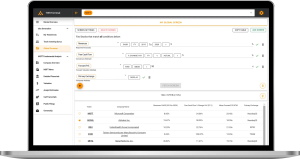Best Stock Screeners of 2024
Stock screening is an integral part of an investor’s research and decision-making process. With a myriad of choices to choose from, we wanted to highlight the most accessible, intuitive, and affordable stock screeners available to investors today.
In our comparison, we focus on platforms that meet the most critical demands of investors seeking to screen for stocks:
- Global universe: Having the world at your fingertips, investors want the freedom to specify which markets they want to dive into, or leave their search open and search a global universe of stocks. A stock screener with a global database is crucial.
- Widely accessible: Web-based, and mostly free, these stock screeners are widely accessible and affordable.
- Flexibility: Being able to specify ranges, growth rates, and having a large database of screening metrics allows an investor to refine their search to the highest level of detail.
- Complimentary tools: Screening is great, but investors also need tools to study the companies they find in their search too. Complimentary tools inside the same platform such as charting, financials, watchlists, news, and analyst estimates are important for the next leg of research.
Compare
Koyfin | TIKR | Seeking Alpha | YCharts | |
Cost of Stock Screener | $0 - $39/mo | $19.95 - $39.95/mo | $239/year | $3,600/year |
Free version |
|
|
|
|
Number of screening metrics | ~500 | ~335 | ~80 | ~500 |
Coverage | Global | Global | US | US |
Available stocks | ~100,000 | ~100,000 | ~17,000 | ~20,000 |
ETF screener |
|
|
|
|
Mutual Fund screener |
|
|
|
|
Koyfin | TIKR | Seeking Alpha | YCharts | |
Financial history | 10Y | 10Y | 8Y | 10Y |
Narrow by ETF constituents |
|
|
|
|
Screen keywords in company description |
|
|
|
|
Screen for forward growth |
|
|
|
|
Forward estimate range | 10Y | 5Y | 3Y | 10Y |
Screen using Percentile Ranks |
|
|
|
|
Download screen results |
|
|
|
|
Screen in multiple currencies |
|
|
|
|
Screen in metric ranges |
|
|
|
|
9 Best Stock Screeners of 2024
Koyfin
Screener: Koyfin’s global stock screener is free and allows investors to search using a library of more than 500 screening metrics. These metrics span across fundamentals, technicals, performance, security-level information, analyst estimates, growth rates and more. The screener is highly customizable, allowing for metrics to be screened in ranges. Additionally, custom ratios can be added to the screening results for sorting and organizing data.
Investors can create multiple screening templates, download their results, and save screening results as watchlists to be used across the rest of the platform.
New users receive a 7-day free trial of Koyfin Pro without needing to input a credit card.
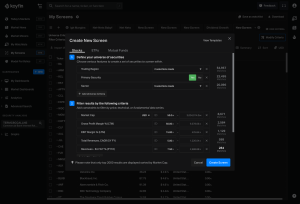
Explore Koyfin Screener: Sign Up Free
Screener Functionality:
Koyfin offers all the key features that both individual investors and financial professionals look for in a high-quality screener.
- Global stock screener
- ETF & mutual fund screener
- Download screen results
- 10Y of financial history
- 10Y of analyst estimates
- Technical screening
- Multiple screening templates
- Premade templates
- Summary rows
- Importable views
- Save to watchlist
- Percentile ranks
- Custom formulas
- Complimentary tools
- Screen in multiple currencies
Highly Customizable
Customizability in screening is crucial. Koyfin’s broad library of screening metrics allows investors to refine their investment universe to the finest level of detail. Even after the screening output is created, Koyfin excels at additional customizability. Investors can group and sort their data, add additional columns, calculate custom formulas, and import table views from their Koyfin watchlists.
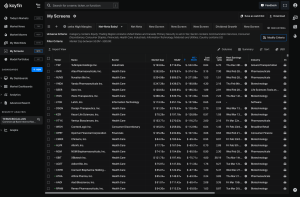
Percentile Ranks
Percentile Ranks are a data series unique to Koyfin and allow investors to quickly grasp where a company’s valuation, margins, or other data points stand in relation to the stock’s history, the industry, or regions. Available in the stock screener, Percentile Ranks range from 0 to 100; with 0 implying the metric is in the lowest percentile and 100 implying the highest.
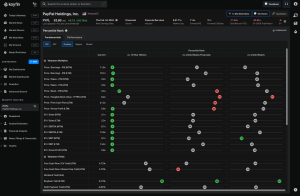
Save as Watchlist
The beauty of Koyfin’s screener is how interoperable it is with the rest of the platform. Investors can save their screen results as watchlists and use them throughout the platform; dropping their basket of screened stocks into features like earnings calendars, charts, market scatter graphs, custom watchlist news feeds, and more.
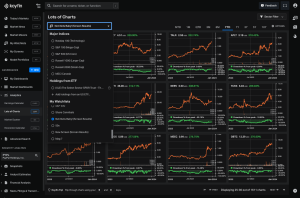
Explore Koyfin Screener: Sign Up Free
Pricing & Plans:
Koyfin offers three pricing plans suitable for a variety of needs. The global stock screener is free with two screening templates for all users, and additional complimentary tools, ETF and mutual screeners, are available in higher tiers.
|
Free |
Plus |
Pro |
|
Free |
$39/month |
$79/month |
|
|
|
|
| • Global stock screener | • Everything in Free | • Everything in Plus |
| • Multiple screen templates | • ETF screener | • Mutual fund screener |
| • Download screen results | • Unlimited screening templates | • US & Canadian mutual fund data |
| • 2Y financials & 1Y estimates | • 10Y financials & 10Y estimates | • Mutual fund holdings |
| • Advanced charting | • Filings & transcripts | • Full US ETF Valuation data |
| • Market & macro dashboards | • Advanced transcript search | • Unlimited custom formulas |
| • Watchlists | • Unlimited watchlists | • Unlimited custom FA templates |
| • Shareable watchlists | • Custom dashboards | • Model portfolio tools |
| • Portfolio tools | • Dashboard data download | • Priority support |
| • Economic & earnings calendar | • 10 custom formulas | |
| • Limited transcripts | • Custom FA templates | |
| • Limited ETF holdings | • Full ETF holdings data | |
| • Limited ETF valuations | • 100k+ global company snapshots | |
| • Limited company snapshots | • Premium news & press releases | |
| • Web-based news | • Custom news feeds |
For a custom fit, explore the Enterprise Plan. It includes everything in Pro, plus custom onboarding, administrative purchasing options, single sign-on, and flexible, scalable pricing. Contact the sales team for inquiries.
See a full comparison of Koyfin’s plans and functionality
|
Pros |
Cons |
|
|
|
| • Free global stock screener | • No futures or crypto screener |
| • ETF & mutual fund screener | • Can’t screen for trading patterns |
| • Premade screening templates | • No options data |
| • Download screening output | • Not designed for active traders |
| • Custom formulas | • Fund screener requires subscription |
| • Simple and intuitive design | |
| • Highly customizable | |
| • Multiple screening templates | |
| • Screen in any currency |
Platform: Koyfin is the Swiss army knife of financial research platforms and the best all-around stock screener for individuals and professionals thanks to its incredible breadth and depth in institutional quality data, customizability, and modern user interface. Trusted by more than 500,000 investors, Koyfin delivers a comprehensive financial data terminal at a price that caters to everyone. You can try Koyfin’s screener for free. New users receive a 7-day free trial of Koyfin Pro without needing to input a credit card.
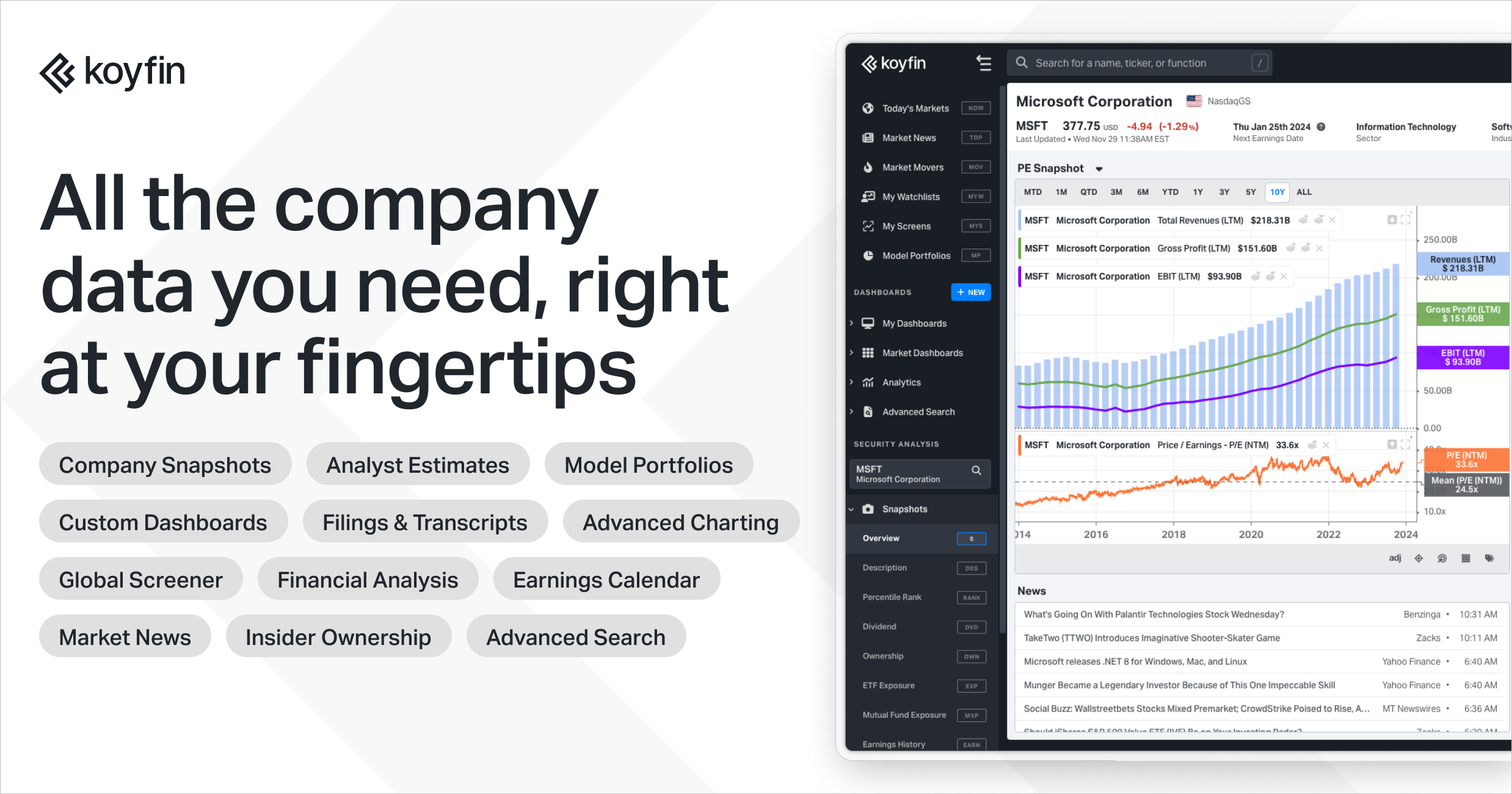
Access Advanced Financial Tools: Sign Up Free
Summary:
Koyfin’s global stock screener is unrivaled in depth and customizability with over 500 unique screening metrics and thousands of variations. While the range of data is vast, it is organized in a simple and intuitive way. The Koyfin terminal is flexible to an investor’s needs with an extensive catalog of features for conducting a multitude of analyses. Investors can control and customize their screening and data, download results, and save these results as watchlists to use throughout the platform. Koyfin’s screener has an eye for detail, exemplified by its ability to adjust screening metrics by currency; a feature no other screener on this list has.
- Price advantage: Unrivaled functionality and data in a global stock screener, at no cost.
- Highly customizable: Incredibly flexible to an investor’s needs, with a range of methods to control and sort through the data.
- Ideal for fundamental analysis: Particularly tailored for fundamental investors, with a comprehensive set of features for in-depth analysis.
Finchat
Platform: Finchat is the birth child of two previously separate sister platforms: Finchat and Stratosphere. The company has successfully integrated the AI capabilities of Finchat with the financial data and analytical strengths of Stratosphere. The result is a unique financial research platform that is both powered and assisted by the use of artificial intelligence. Finchat is particularly suited to individual investors with affordable pricing and AI assistance but also caters to professionals through a rich spectrum of fundamental data and tools.
Screener: Finchat’s stock screener is unique in that it allows investors to screen based on generative AI prompting. Outside of generative AI, the traditional screener allows investors to search a global database of stocks with over 300 screening metrics, the ability to set ranges.
Functionality:
- Global stock screener
- ~335 screening metrics
- 10Y of financial history
- 3Y analyst estimates
- Generative AI assistance
- Multiple screening templates
- Complimentary tools
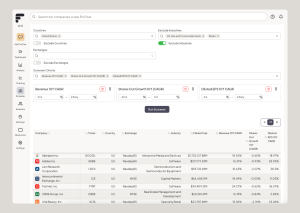
Pricing & Plans:
Finchat offers three pricing plans, with the screening capabilities available in all plans. The largest difference when scaling through tiers are the number of AI prompts:
- Free: Finchat’s free plan offers a global database of stocks to screen from, in addition to 25 prompts of Finchat AI per month and 5Y of financial history.
- Plus: Priced at $29 per month, the Plus plan includes 100 prompts per month and 10 years of financial data.
- Pro: Price at $79 per month, the Pro plan contains everything in the Plus plan, in addition to 1,000 prompts per month.
For more details on the rest of the data in FinChat’s pricing plans, visit their website.
|
Pros |
Cons |
|
|
|
| • Global stock screener | • No ETF or mutual fund screener |
| • Generate AI assistance | • Can only screen in USD |
| • Intuitive interface | • Unable to download screening outputs |
| • Ability to set ranges | |
| • Free version |
Summary:
Finchat offers a global database of stocks and a screening tool, for free, right from the get-go, as well as a limited number of AI prompts. That is commendable. As you cycle up through the paid tiers, the number of AI prompts increase, as does the depth and breadth of the complimentary tools that support financial research. With a simple and intuitive design and AI assistance, the Finchat stock screener is a great one. Minor limitations include the lack of a fund screener, the inability to download screening results, and the ability to customize the screening output table outside of what is selected in the screening criteria.
Finviz
Platform: Finviz is a financial research website that offers investors a range of tools to visualize their research such as screeners, heatmaps, and portfolios. It was created in 2007 and has remained a popular choice for individuals ever since. Fitted with unique screening parameters such as trading patterns, real-time data, and backtesting capabilities, Finviz is especially tailored to active traders.
Screener: Finviz is a legacy stock screener that, while dated compared to modern platforms, performs the screening function amicably. The screener is limited in the number of metrics it provides in the free plan, but does offer unique parameters for traders that are hard to find elsewhere. It’s simple and intuitive design and technical screening criteria make it ideal for fast screening.
Functionality:
- US stock screener
- ~70 screening metrics
- Technical screening metrics
- Trading pattern screening
- Complimentary tools
- Export screen outputs
- 8Y of financial history
- Multiple screening templates
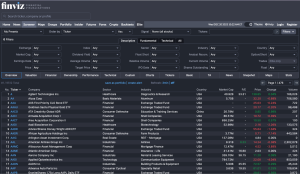
Pricing & Plans:
Finviz offers three pricing plans, with the screening capabilities scaling through the tiers:
- Free: Finviz’s free plan provides users with delayed screening data for US stocks with 3 years of financial history, and is limited to 20 rows per table. Users are not able to customize the layout, set ranges for screener metrics, export data, or create screener templates.
- Registered: The registered plan is free and rewards registered users with additional features. The plan includes everything in Free but allows users to customize the layout of the screener.
- Elite (paid): Priced at $39.50 per month, the Elite plan contains everything in Registered, as well as real time screening data, 8 years of financial history, 100 rows per table, screener export, the ability to set ranges in screening metrics, and set alerts.
For more details on the rest of the data in Finviz’s pricing plans, visit their website.
|
Pros |
Cons |
|
|
|
| • Simple and intuitive design | • Limited number of screening metrics |
| • Export screening output | • Only US stock coverage |
| • Trading pattern screening metrics | • No ETF or mutual fund screener |
| • Ease of use | • Limited free plan |
| • Suited to swing trades | • Not suited to fundamental investors |
Summary:
Finviz is a simple and intuitive screener that has been popular for decades; ideal for fast market scanning. The ability to screen for specific trading patterns is unique, and the rest of the platform includes complimentary tools for screening outputs such as the ability to set alerts, turn the output in a portfolio, and export the data. While ease of use is important, Finviz’s library of screening metrics, particularly those in the fundamental department, are too limited when compared to modern alternatives. Moreover, the inability to set ranges for screening inputs in the free version is a significant limitation.
TradingView
Platform: TradingView is a popular platform that specializes in charting and technical analysis tools across a variety of asset classes and data sets like stocks, funds, futures, forex, crypto, bonds, and macro. It offers extensive charting capabilities with a vast library of indicators and drawing tools, real-time data, and a community-driven platform where users can share insights and strategies. The platform is best suited to active traders.
Screener: Tradingview’s stock screener offers investors a global range of stocks to screen with over 150 screening metrics across fundamental and technical data series. For advanced traders, TradingView provides a proprietary scripting language called Pine Script, enabling the creation of custom indicators and alert systems. Tradingview also features screeners for ETFs, crypto, and forex.
Functionality:
- Global stock screener
- ~150 Screening metrics
- ETF, crypto, and forex screener
- Autorefresh
- Alerts
- Complimentary tools
- Pine script editor
- Community platform
- Premade screen templates
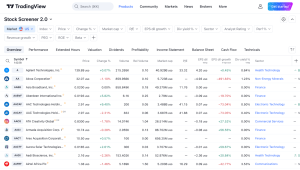
Pricing & Plans:
TradingView offers seven pricing plans and differentiates them by non-professional and professional:
- Basic: The basic plan is free and does not include screener auto-refresh and data export options. It offers multiple timeframes like daily, weekly, and monthly for screening. Coverage includes 150+ exchanges from over 50 countries and multiple markets. Crypto and currency screeners are available, as well as access to over 100 fundamental and technical fields. Only one color is available for flagged symbol colors.
- Paid non-professional: The essential ($12.95 per month), plus ($24.95 per month), and premium ($49.95) plans all offer full access to the screener features, including auto-refresh, data export, all timeframes, extensive exchange and market coverage, crypto and currency screeners, over 100 fundamental and technical fields, and seven colors for flagged symbols.
- Paid professional: The expert ($199.95 per month), elite ($349.95 per month), and ultimate ($499.95 per month) plans all offer full access to the screener features, including auto-refresh, data export, all timeframes, extensive exchange and market coverage, crypto and currency screeners, over 100 fundamental and technical fields, and seven colors for flagged symbols.
For more details on the rest of the data in TradingViews’ pricing plans, visit their website.
|
Pros |
Cons |
|
|
|
| • Global stock screener | • Limited fundamental screening metrics |
| • Free version | • Design can be overwhelming |
| • Technical screening metrics | • Real-time data comes at extra cost |
| • Pine script editor | |
| • Customizable | |
| • Export screen results |
Summary:
Tradingview’s stock screener allows users to conduct the fundamentals of screening for free, and with a global database of stocks. While the navigation may be confusing for those not used to TradingView, with a little experience the screener becomes a powerful tool for any investor. The screening results table is customizable, allowing investors to add new columns, and the results are exportable. Pair this with the rest of TradingView’s complementary features in charting, and you have yourself a solid global stock screener.
YCharts
Platform: YCharts is a comprehensive financial platform that offers users a wide variety of data and investment analysis tools. Its core features include intuitive visualization capabilities, tools for financial analysis and portfolio management, and an impressive depth of macroeconomic data. Given its price point, the platform largely caters to professional advisors, asset managers, and teams with a variety of plans available.
Screener: YCharts offers a comprehensive stock screener that integrates with its entire platform, allowing for an efficient approach to idea generation and stock picking. This screener is noted for its powerful customization, which aligns with an investor’s unique strategy through custom Scoring Models. These models enable users to weigh the factors they consider most critical.
Functionality:
- Global stock screener
- Fund screener
- Alerts
- Excel add-in
- Export screen results
- Complimentary tools
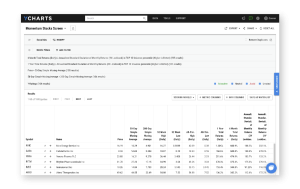
Pricing & Plans:
YCharts offers four pricing plans but doesn’t publicly disclose prices. WallStreetZen, a third-party review site, claims the prices range from approximately $3,600 per year for the entry-level plan to $6,000 per year for the professional plan.
The full range of screening capabilities is available in the analyst, professional, and enterprise plans, which range from $3,600 to $6,000 per year. The presenter plan does not contain stock screeners.
For more details on the rest of the data in YCharts’ pricing plans, visit their website.
|
Pros |
Cons |
|
|
|
| • Large number of screening metrics | • Overtly expensive |
| • Alerts | • No free stock screener |
| • Excel add-in | • Limited number of international stocks |
| • Export screening results | |
| • Highly customizable |
Summary:
YCharts has a fantastic stock screener, with a large number of screening metrics, customizable range options, the ability to save templates, alerts, and export data. However, compared to the cost of other alternatives on this list, most of which are free, YCharts’ stock screener starts at ~$3,600 per year. It’s certainly one of the most advanced and customizable screeners on our list, but when factoring in the price, there are more practical alternatives with just as much power, suited to both individuals and professionals. Compared to alternatives, YCharts’ international stock database is sparse.
Yahoo Finance
Platform: Yahoo Finance is a versatile platform that provides a variety of financial data, news, and tools for investors. The platform provides real-time stock quotes, charting, financial news, data analytics, and a personal finance section covering a wide range of topics from retirement planning to mortgage rates.
Screener: Yahoo Finance offers screeners for stocks, mutual funds, ETFs, futures and indices. The stock screener offers investors a range of ~95 screening metrics across a basic range of variables. Users can create and save custom screeners, and paid subscribers can benefit from Yahoo’s predefined screens to help users quickly identify stocks that match popular investment strategies. The platform is known for its user-friendly interface, making it accessible to novice investors.
Functionality:
- Global stock screener
- ETF and mutual fund screener
- Futures & indices screener
- ~95 screening metrics
- Complimentary tools
- Export screen outputs
- Heatmap view
- Multiple screening templates
- Premade screeners
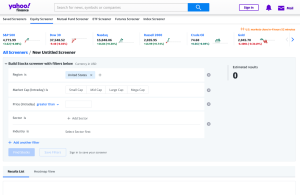
Pricing & Plans:
Yahoo Finance offers three pricing plans, with the screening capabilities scaling through the tiers:
- Free: Yahoo Finance’s free plan offers investors a range of ~95 screening metrics and the ability to search through a global database of stocks. Registered account holders can also save screening templates.
- Plus Lite: Priced at $25 per month, the Lite plan doesn’t introduce new screening capabilities, but it does remove ads, introduce live support, and unlock various features related to other areas of Yahoo Finance.
- Plus Essential: Priced at $35 per month, the Essential plan contains everything in the Lite plan, as well as the ability to export screening outputs as a CSV. It also introduces richer features for other areas of the Yahoo Finance platform.
For more details on the rest of the data in Yahoo Finance’s pricing plans, visit their website.
|
Pros |
Cons |
|
|
|
| • Global stock screener | • Unable to export screening output in free plan |
| • ETF, mutual fund, futures, and indices screener | • Duplicates international stock in output |
| • Ease of use | • Premium data limited to US stocks |
| • Great for novice investors | • Limited number of screening metrics |
| • Can only screen in USD |
Summary:
The Yahoo Finance screener is a great tool for newer investors, offering a global selection of stocks with basic screening metrics, and is presented in a simple and intuitive design. The range of complimentary tool also support the screening tool, and the platform also allows investors to search for funds, futures, and indices. A paid subscription will unlock greater capabilities for investors who screen often; most notably the ability to save screening templates and export data. For more advanced investors, however, Yahoo Finance is a tad basic and lacks the depth of screenable metrics and customizability that other platforms have.
Zacks
Platform: Zacks is a widely recognized firm known for its quantitative and qualitative analysis of publicly traded companies, primarily focusing on providing investment research and recommendations. Established in 1978, it offers a range of financial services, including analytical tools, data, and stock ratings. Zacks is perhaps best known for its ranking system that categorizes stocks into five groups, ranging from ‘Strong Buy’ to ‘Strong Sell,’ based on their earning potential. The firm’s research is intended to guide individual and institutional investors in making informed investment decisions, utilizing a combination of expert analysis, algorithms, and proprietary models.
Screener: The Zacks Stock Screener is a tool designed to help investors and traders filter and search for stocks based on various criteria such as price, market cap, dividend yield, and many others, including the proprietary Zacks Rank. It’s part of the broader suite of services offered by Zacks Research, intended to provide users with a user-friendly interface and a wide array of customizable options to identify potential investment opportunities. However, with time the screener has failed to keep up with modern platforms, offering a limited range of screener metrics with minimal customizability. Moreover, the screener is primarily centered around Zacks own ratings and data, which means it’s necessary to understand and consider the methodology behind Zacks’ ratings when using the screener for investment decisions.
Functionality:
- US stock screener
- ETF and mutual fund screener
- ~150 screening metrics
- Complimentary tools
- Export screen outputs
- Premade screeners
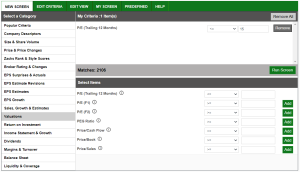
Pricing & Plans:
Zacks offers five pricing plans, with the screening capabilities scaling through the tiers:
- Free: Zacks’ free plan provides users with ~120 screening metrics and excludes the Zacks rankings that they have developed.
- Premium: The Premium plan, priced at $249 per year, provides users with an additional 15 Zacks ranking scores as well as premade premium screen templates.
The remaining plans, priced between $495 and $2,995 per year, have limited bearing on additional screening capabilities. The higher-tiered plans largely unlock additional tools, research reports, and publications from the Zacks Investment Research business.
For more details on the rest of the data in Zacks’s pricing plans, visit their website.
|
Pros |
Cons |
|
|
|
| • ETF and mutual fund screener | • Unable to screen for ranges in metrics |
| • Simple design | • Limited number of screening metrics |
| • Export screening output | • Only US stock coverage |
| • Ease of use | • Lack of real time information |
| • Limited free plan |
Summary:
Similar to Finviz, Zacks is a legacy screener that has been around the block, and remained somewhat popular throughout the years. In a similar fashion, it has failed to keep up with the modern platforms today. While some basic screening metrics are available for free, a premium package is required to unlock the full potential of the screener. The screener is not as robust as others on this list, and the number of screening metrics.
Seeking Alpha
Platform: Seeking Alpha is a financial research and news publishing platform where individual investors share their perspectives to paying subscribers. The platform also offers subscribers a range of tools such as watchlists, screeners, portfolios, charting, financials, proprietary rankings, and publications. The operating model of Seeking Alpha ensures a variety of perspectives on stocks.
Screener: Seeking Alpha’s stock screener, which requires a paid subscription is particularly noted for its integration with the platform’s extensive research and data, offering users an opportunity to base their stock picks on a blend of quantitative metrics and qualitative insights. It also includes Seeking Alpha’s proprietary ratings, which are derived from the collective input of its contributor community. These ratings, combined with traditional screening filters, offer a unique approach to stock selection.
Functionality:
- Global stock screener
- ~80 screening metrics
- ETF screener
- Complimentary tools
- Premade screeners
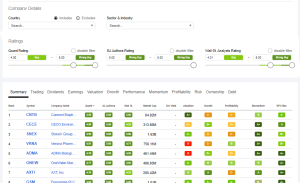
Pricing & Plans:
Seeking Alpha offers three pricing plans, but unfortunately does not offer a free version of a stock screener.
- Free: No access to stock or ETF screener.
- Premium: Priced at $239 per year, the Premium plan unlocks the Seeking Alpha stock screener and ETF screener which comes with ~80 screening metrics which include a variety of proprietary rankings. Users can save screening templates and benefit from the range of premade templates the platform offers.
- Pro: Priced at $2,400 per year, the Pro plan includes everything in Premium, as well as greater variety in complementary research tools and publications.
For more details on the rest of the data in Seeking Alpha’s pricing plans, visit their website.
|
Pros |
Cons |
|
|
|
| • Community of investor perspectives | • Screener requires paid subscription |
| • Extensive library of complementary tools | • Unable to export screening output |
| • Global stock screener | • Limited number of screening metrics |
| • ETF screener |
Summary:
Seeking Alpha is a great platform for investor perspectives. However, because the platform is a publishing body first, and a research tool second, the majority of the tools are locked behind an annual subscription. This makes sense if an individual wants to become a member of the community, but is not ideal for investors looking to find free or affordable investment research tools. While the screener is a great addition to the Seeking Alpha premium subscription, because of its overreliance on proprietary rankings and limited depth in screening metrics compared to free alternatives, it’s not the greatest value for investors looking solely for a stock screener.
FAQ
-
What is a stock screener?
A stock screener is a tool that investors and traders use to filter stocks based on specific criteria. For example, you can use a stock screener to find stocks that meet certain financial metrics like earnings, market capitalization, or industry sector.
-
What features are essential in choosing a stock screener?
When choosing a stock screener, look for:
Range of Criteria: It should offer a wide range of variables to filter, like price, volume, fundamentals, and technical indicators.
User-Friendly Interface: The tool should be easy to use and understand.
Data Accuracy: Ensure it provides up-to-date and accurate data.
Customizability: The ability to save your screening criteria for future use is helpful.
Integration: Some screeners offer integration with other investment tools or platforms.
-
What are the different types of stock screeners?
There are mainly three types:
Basic Screeners: These are often free and offer simple filtering options.
Fundamental Screeners: They focus on financial metrics like revenue, profit margins, and dividend yields.
Technical Screeners: These are used for technical analysis and might include filters based on chart patterns or technical indicators.
Editorial note
Our insights are derived solely from historical information and analyst predictions, employing an impartial approach. Please note that our articles do not serve as financial guidance.

